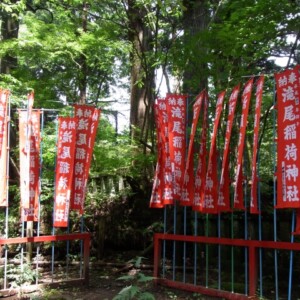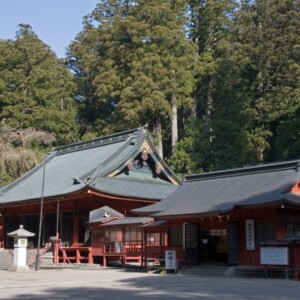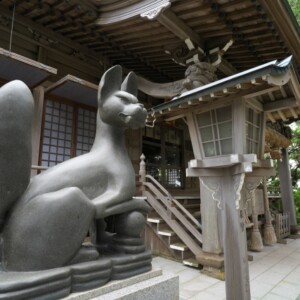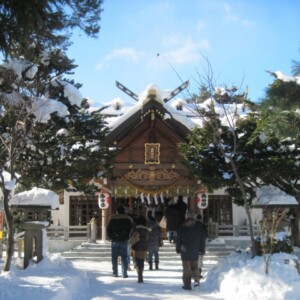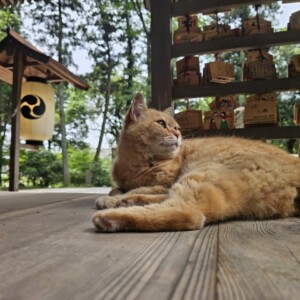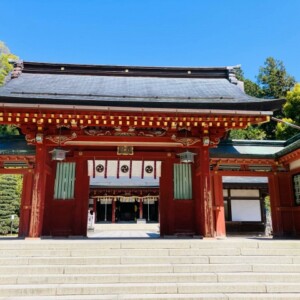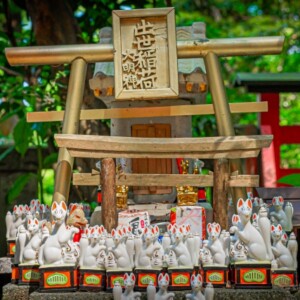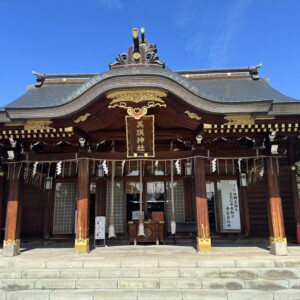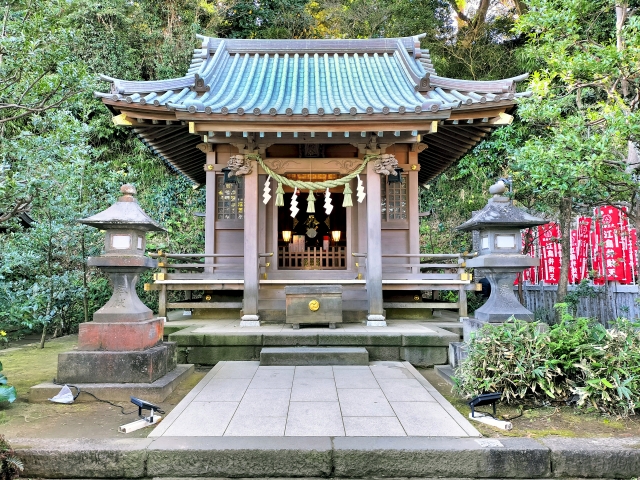
Yasaka Shrine|Complete guide to the history, highlights, and worship information of this historic shrine
Yasaka Shrine, located in Jonan, Fujisawa City, is well known in the community as a historic shrine dedicated to Susano-no-mikoto. It is unusual in that it stands on the same site as the Yotsuya Inari Shrine, and every year in July, local people gather for the portable shrine procession festival, which is a lively celebration of the shrine. Located in a residential area between the old Tokaido Highway and the Fujisawa Bypass, the shrine’s tranquil precincts offer a peaceful place to worship.
Outline and basic information about Yasaka Shrine
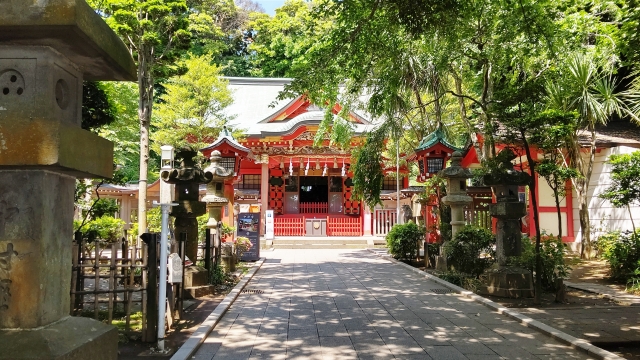
Yasaka Shrine is located at 5-1-8 Jonan, Fujisawa City, Kanagawa Prefecture, and is an official shrine registered with the Kanagawa Prefectural Shrine Office. Yotsuya Inari Shrine is also erected on the same site, providing an unusual sight of two shrines standing side by side.
The shrine grounds are located between the old Tokaido Highway and the Fujisawa Bypass (National Route 1), and are tucked away in a residential area. Passing through the steel torii gate and up the stone steps, visitors are greeted by a large hontsubo bell hanging from the hall of worship.
History and Origin
The detailed date of Yasaka Shrine’s founding is not clear, but the shrine has been protected by the local people since ancient times. As one of the approximately 2,300 Yasaka shrines in Japan, it follows the Gion faith, with Yasaka Shrine in Kyoto as its head shrine.
During the Edo period (1603-1867), the shrine was once worshipped as Ushitotenno-sha, and was renamed Yasaka Shrine in the Meiji period (1868-1912) under the Shinto and Buddhism Separation Order. The shrine has long been known locally as “Otenno-sama,” and has been worshipped as a god to ward off plague and evil.
Deities and Benefits
The deity of Yasaka Shrine is Susano no Mikoto. He is known as the younger brother of Amaterasu and plays an important role in Japanese mythology.
Because of his extremely powerful divine character, Susano no Mikoto has long been worshipped as a god who exorcises various bad lucks and disasters, including epidemics. He is especially believed to be beneficial for healing illnesses, driving away misfortune, and banishing calamities, and is revered as a guardian deity to protect the health and safety of local people. It is also known as the god of agriculture and the god of storms, and is visited by many worshippers to pray for a good harvest and prosperous business.
Yasaka Shrine Highlights and Features
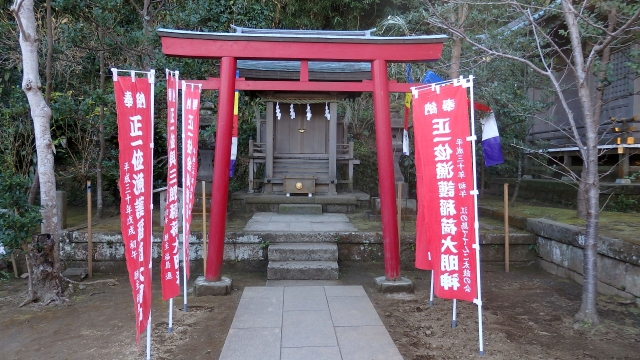
The grounds of Yasaka Shrine are not large, but they are an interesting space with a concentration of attractions. From the approach to the shrine to the hall of worship, one can feel the depth of history and faith in each of them.
Architectural and Structural Attractions
At the entrance to the shrine grounds stands a torii gate that appears to be made of steel, from which visitors ascend approximately 20 stone steps to reach the hall of worship. Although the hall of worship is a relatively new structure, it retains the style of traditional shrine architecture, and the beauty can be seen in the curves of the roof and the decoration of the eaves.
A large Hotsubo bell hangs from the front of the hall of worship, and visitors ring this bell when they pray to the gods. The sound of the bell echoes through the shrine grounds, creating a sacred atmosphere. Inside the hall of worship, a flat plaque reading “Yasaka Shrine” is displayed, indicating the prestige of the shrine.
Coexistence with Yotsuya Inari Shrine
The most distinctive feature of Yasaka Shrine is that Yotsuya Inari Shrine stands side by side with Yasaka Shrine on the same site. The deity of Yotsuya Inari Shrine is the deity Ukemochinokami, who is believed to be in charge of food and the five grains.
The two shrines stand next to each other, each with its own separate hall of worship, but forming a unified precinct. The two oblong plaques, “Yasaka Shrine” and “Inari no Taimeishin,” hang side by side in the hall of worship, symbolizing the coexistence of the two shrines. This form is rare and speaks to the diversity and tolerance of local beliefs.
Stone Buddha and a monument in the precincts of the shrine
At the rear of the temple grounds is the Yotsuya Town Hall, and in front of it are several stone Buddhas and stone pillars, including a Jizo and a Koshinto (a pagoda for the study of the soul). These stone structures are valuable cultural assets that tell the history and culture of the area.
Of particular note is a stone pillar inscribed with “Monument in Honor of Kotaro Okahana,” which is said to honor the businessman associated with Fujisawa City. The Jizo-san also has a very neat face, and two divine messengers with distinctive heads stand protectively on either side of him at his feet. These stone structures are proof that the shrine has played a central role in the local community.
Guide to Worship and Visitation
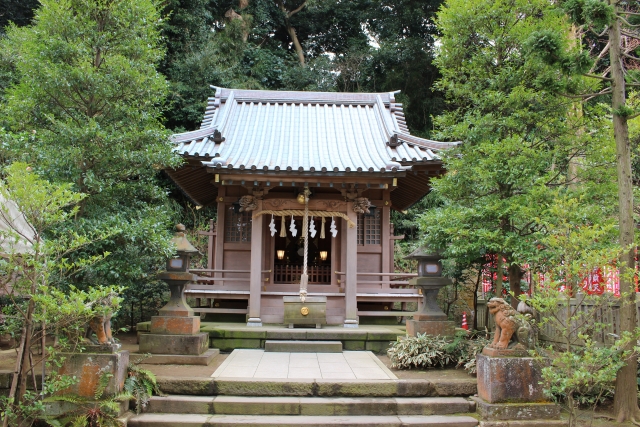
Yasaka Shrine is a community-based shrine that welcomes many visitors throughout the year. The grounds are open 24 hours a day and visitors are welcome at any time, but it is important to observe proper etiquette and manners.
Worship Etiquette and Manners
Visiting Yasaka Shrine is done in accordance with general shrine etiquette. First, bow lightly when passing through the torii gate, and walk down the approach to the shrine, avoiding the center of the path. If there is a handbasin, purify your left hand, then your right hand, and then your mouth, in that order, before proceeding to the hall of worship.
At the hall of worship, bow in the manner of “ni-ai ni clap-toe ichi-ai” (two claps, one hand, one bow). After paying money, ring the large Hontsubo bell, bow deeply twice, clap twice in front of the chest, and bow deeply again at the end. When visiting the shrine, it is important to offer prayers of gratitude.
Since the temple grounds are located in a residential area, please refrain from loud conversations and noisy behavior, and try to visit the shrine quietly. Also, when taking pictures, please remember to be considerate of other worshippers.
Annual Events and Mikoshi-togyo Festival
Yasaka Shrine holds annual festivals on July 11 and July 15. The most notable event is the Mikoshi Togyo Festival, in which a portable shrine is carried by the local Ujiko (shrine parishioners) in a spirited procession through the town. This festival is regarded as an important annual event in the community and attracts many spectators.
The portable shrines of Yasaka Shrine and Yotsuya Inari Shrine both participate in the portable shrine procession, symbolizing the unity of the community and the passing on of traditional culture. During the festival, the shrine grounds are decorated with lanterns, creating an unusual and festive atmosphere.
Other annual events include the New Year’s Day New Year’s Day Festival, the Spring Prayer Festival, and the Autumn New Year’s Tasting Ceremony, where prayers are offered according to the season. It is recommended to check the detailed schedule in advance.
Red Seal and Good Luck Charm Information
Yasaka Shrine’s red seal and prayer services are managed by Kugenuma Kotai Jingu. Please contact Kugenuma Kotaijingu if you wish to obtain a red seal. Kugenuma Kotai Jingu is a leading shrine in Fujisawa City and manages the rituals of several shrines and can provide professional support.
Amulets and prayer charms are also available at Kugenuma Kotai Jingu Shrine. Various types of amulets are available, such as those for warding off bad luck, healing illness, and family safety, and can be selected according to the wishes of the individual.
For more information on hours and fees, please contact the Kugenuma Kotai Jingu Shrine directly or visit the official website.
Access and Use Information
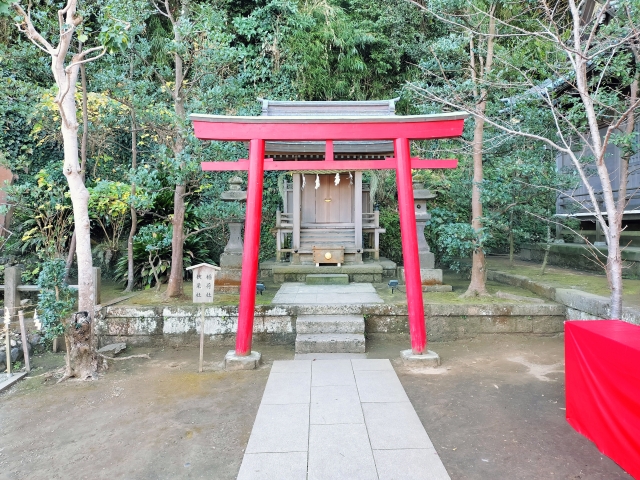
Yasaka Shrine is easily accessible from central Fujisawa City and can be visited by public transportation. Its location in a residential area provides a quiet environment for worship.
Transportation Access
The nearest station is Tsujido Station on the JR Tokaido Line, about a 15-minute walk from the station. From Tsujido Station, the most common route is to walk along the old Tokaido Highway toward the Fujisawa Bypass.
To access from Tsujido Station, take the north exit of the station and head east along the old Tokaido Highway into the area between the station and the National Route 1 Fujisawa Bypass. Since the route takes you through a residential area, it is recommended that you check the map in advance.
If using a bus, the closest bus stop is Yotsuya, which is on the route from Fujisawa Station, but the number of buses is limited, so it is important to check the access with the train in advance.
Access by car is also possible, but since there is no dedicated parking area on the temple grounds, we recommend using coin-operated parking in the area or taking public transportation.
Hours of visitation, fees, and parking information
Yasaka Shrine is open to visitors 24 hours a day, 7 days a week. There is no admission fee, and everyone is welcome to visit the shrine.
However, it is important to visit the shrine quietly at night, considering that it is located in a residential area.
There is no dedicated parking lot on the grounds. If you wish to visit the temple by car, we recommend that you use coin-operated parking lots in the vicinity or take public transportation if possible. There are several parking lots in the Tsujido Station area, but we recommend that you allow plenty of time for your visit, as congestion is expected on festival days.
Regarding barrier-free facilities, there are some restrictions on wheelchair access to the temple grounds, as it is necessary to climb stone steps to reach the temple. If you wish to visit the shrine, please consult with the Kugenuma Kotai Jingu Shrine, which manages the shrine, in advance.
Address: 5-1-8 Jonan, Fujisawa-shi, Kanagawa 251-0057
Reference site
Kanagawa Prefectural Shrine Office: https://www.kanagawa-jinja.or.jp/shrine/1206031-000/



